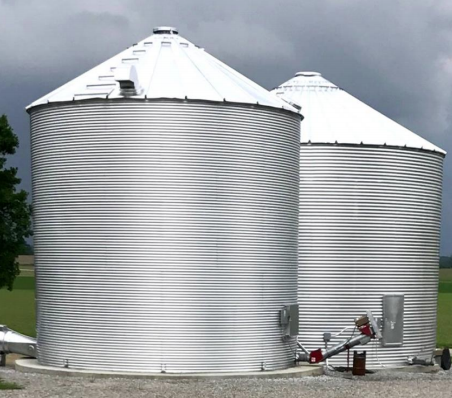Farmer Dies in Grain Bin Engulfment Accident
 On Tuesday, March 17, 2020, a 44-year-old male farm employee (victim) was unloading corn from a large, 80,000-bushel grain bin via a bottom mounted auger. During the course of the unloading process, the flow of corn seized due to bridged corn.
On Tuesday, March 17, 2020, a 44-year-old male farm employee (victim) was unloading corn from a large, 80,000-bushel grain bin via a bottom mounted auger. During the course of the unloading process, the flow of corn seized due to bridged corn.
According to OSHA, “bridging’’ occurs when grain clumps together, because of moisture or mold, creating an empty space beneath the grain as it is released. Bridged grain resists the downward pull that normally moves loose grain to the bin outlet and rarely becomes hard enough to support a person” (OSHA, 2011).
The farm worker entered the gain bin without utilizing fall protection and used a large PVC-pipe to push and spread the corn. While doing so, the bridged corn unexpectedly collapsed. The victim fell and was engulfed by the corn as it began to flow again. A farm employee working on the exterior of the grain bin stated to authorities that he could no longer hear the victim inside the grain bin. The co-worker climbed to the top of the grain bin to look for the victim, but could not see him due to the collapsed corn.
After the co-worker descended from the top of the grain bin, he asked a farm employee to contact emergency services to advise that a farmworker had been involved in a grain bin engulfment. In addition to emergency services, a second co-worker at the farm also contacted several members of neighboring farms to assist with the rescue of the victim.
Emergency personnel arrived on scene approximately 30 minutes after receiving the call. Upon arrival, local volunteers from surrounding farms were prepared to cut an opening in the grain bin with a torch in an attempt to rescue the engulfed farm employee as quickly as possible. EMS and farm employees discussed the potential risk of fire and it was determined that cutting into the bin was not the best recovery option. EMS worked together with local volunteers to free the victim for several hours by unloading the corn onto trucks. Once the majority of the corn had been unloaded, EMS utilized the Jaws of Life, a hydraulic cutting apparatus, to recover the victim.
The recovery lasted nearly four hours and the body was freed at 2:43 PM. Upon recovery, the victim was pronounced deceased at the scene by the local coroner.
The cause of death was suffocation.
Occupational injuries and fatalities are often the result of one or more contributing factors or key events in a larger sequence of events that ultimately result in the injury or fatality. Kentucky FACE investigators identified the following unrecognized hazards as key contributing factors in this incident:
- Lack of hazard recognition
- Failure to utilize fall protection
- No emergency action plan


